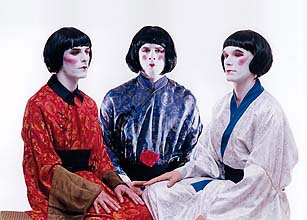The present-day hype surrounding VJ-culture could almost make you forget that many of the concepts and formats used by VJs and DJs stem and are borrowed from a long tradition of audio-visual experiments. Whether mere lightshows or full sampladelic scratch bliss, they all aspire to certain aspects of the synaesthetic experience, the merging of the senses thru artistic creation. Facilitated by the latest software and hardware, VJs are able to match visually what their DJ counterparts are doing by sampling, cutting and scratching in music. So visiting clubs and raves you are bound to see quotations from film and other visual media being cut, mixed and processed to the rhythm of the music. In most cases this tends to result in a kind of PoMo turmoil of imagery, where all reference and meaning in the source material has been obliterated.
The German trio Rechenzentrum, however, is not your typical VJ collective. Originally formed at Documenta ’97, musicians Marcus Weiser and Christian Nikolaus Conrad, and Lillevän, the group’s video artist, have worked together as a multimedia unit for several years now. Although they have toured extensively in the house and techno club scene, their favorite position has increasingly become the middle ground, the no-man's-land in between club culture and the media arts. Criss-crossing from high art spaces, like the Museum Ludwig in Cologne, to Hong Kong's legendary "Chemical Suzie" den, they call themselves ‘Szenenhopper’ and explore areas of artistic communication and pop entertainment.
The defining purpose behind Rechenzentrum can best be summarized as the exploration of new processes in music/moving image production, in an effort to refine forms of presentation to create an on-stage dialogue between audio and visual media. ‘At the outset of Rechenzentrum we decided and defined our project as a ‘band’, in which audio and video are equally important; we use video as an instrument, and we treat music visually’, according to Lillevän. Being the visual artist of the band, Lillevän is very aware of his sources of inspiration. Apart from DADA, Lettrism and Burroughs, he also cites experimental film from the ’20s and the Bauhaus movement as important reference points for Rechenzentrum's visual experiments. Both formal and literal quotations from films like Hans Richter’s ‘Rhythm 21’ and Viking Eggeling’s ‘Horizontal-Vertical Orchestra’ are readily apparent in a Rechenzentrum set to those more literate in film history. It’s not a mere PoMo sampladelic affair because, as Lillevän clearly states: ‘...we search for what lies beneath the surface of the music or the moving image. The samples from film and music we choose for their potentiality, not their hook line.’ And ‘It’s all stripped down sampled images, I don’t film anything. Then I strip it down, try to find the skeletons, the essence...’
There is an apparent kinship with these early abstract films which goes beyond mere visual effect. Most of the filmmakers from this period, like Oskar Fischinger and Lazlo Moholy-Nagy, had a background in the pictorial arts and they attempted to use the medium of film to transpose abstract forms onto a time axis and to rhythmicise them (in a way that was often close to music). Although Rechenzentrum seems to start at the opposite end of the hi-tec spectrum, the resulting imagery is very similar in its abstract purity of rhythm and movement.
A point in case is last year's CD/DVD release ‘Director’s Cut’ (awarded the ARS Electronica prize). Each piece was conceived from the outset as a symbiotic unity of sound and vision. Abstract images mutate in synch with the rhythmic pulsations of the music; they seem to underline and enhance the textural quality of the soundscapes. Although the music – ranging from minimal techno to spacious and dubby grooves – can be appreciated separately on the CD, the full impact of the project is only experienced through the DVD.
By contrast with the DVD-production, Rechenzentrum’s live performances are largely improvised. Lillevän characterizes their set as improvisational, sometimes irritating, sometimes melancholic, from pleasing to aggressive. Projecting their imagery not only on a screen, but also onto themselves as they, the performers, become part of the transformational process. Total immersion. Building up slowly, sound layer upon sound layer, image upon image, Marcus Weiser and Lillevän create an ever evolving organic form...
